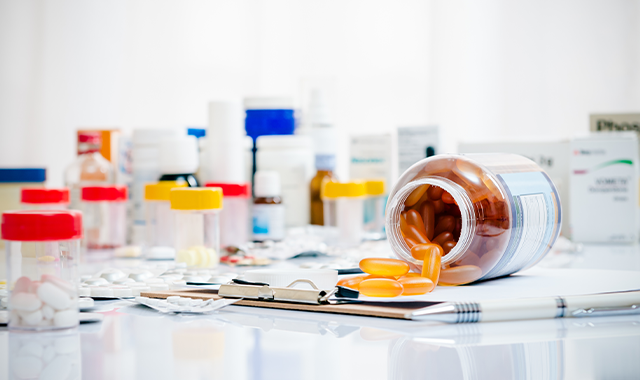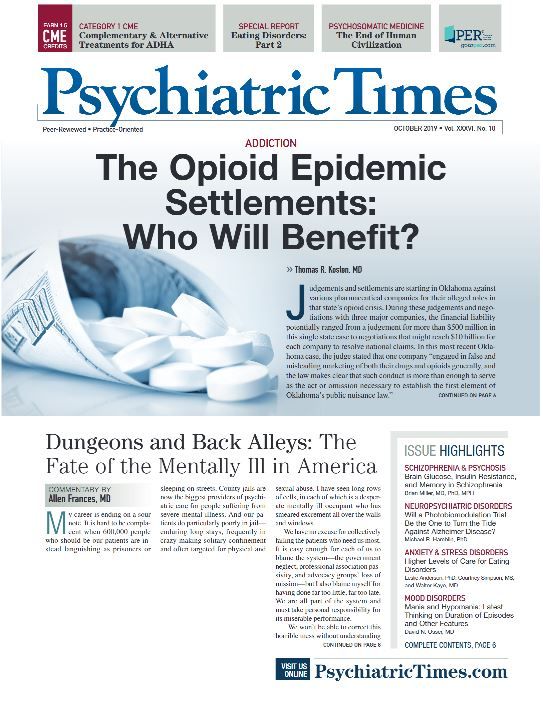Publication
Article
Psychiatric Times
6 Ways to Protect the Kidneys While Prescribing Lithium
Author(s):
Bipolar disorder itself is a risk factor for renal impairment, and myths abound about lithium’s effect on the kidneys. Here are tips to mitigate potential damage.
©psphotography/AdobeStock <br/>

RESEARCH UPDATE
Introduction
When lithium works in bipolar disorder, it tends to work for the long term. That’s a good thing for the 30% to 40% of patients with bipolar disorder who are lithium responders.1 It means they can stay well longer with fewer medication changes. They can also benefit from the medical benefits of lithium, which include a lower risk of stroke, heart disease, cancer, neurologic illnesses, dementia, and all-cause mortality.2 Unfortunately, all of these benefits come at a cost to the kidneys.
Related content: Psychiatric Times Bipolar Disorder Podcast
Does lithium harm the kidneys?
While most studies suggest that long-term lithium use can impair renal function, the link is not 100% clear. Bipolar disorder itself is a risk factor for renal impairment, as are the medical conditions that tend to congregate with it: cardiovascular disease, hypertension, and diabetes.3 About a third of the research has failed to confirm the association between lithium and renal impairment, and two large studies found that anticonvulsants posed a greater risk to the kidneys than lithium.4,5
The reason for this confusion is that nearly all the data is uncontrolled. It takes around 30 years for renal problems to develop in patients taking lithium, and we are unlikely to see controlled trials that last that long. Limitations aside, what we can glean from the available data is:
1. Lithium can impair the kidneys, mainly by lowering the glomerular filtration rate
2. These impairments rarely progress to end-stage renal disease
3. Anticonvulsants, and possibly antipsychotics, are also implicated in the problem5,6
Tip 1. Avoid toxicity
The link between lithium and renal dysfunction may be explained by exposure to toxic lithium levels. Toxic levels kill renal cells, and that damage builds up every time the level rises above the toxic line.
This theory is confirmed by a handful of studies, which have found that lithium does not seem to harm the kidneys when kept below 0.8 mmol/L but renal impairments rise with the number of toxic exposures.7 This is welcome news if proven true, because the recommended level for lithium maintenance is 0.6-0.8 mmol/L. Higher levels (up to 1.2 mmol/L) are usually only necessary for acute mania.8
Tip 2. Keep the level low
Keeping the lithium level as low as possible can prevent renal impairment. The ideal level needs to be personalized and tends to fall with age.
For patients over 60, the recommended level is 0.4-0.6 mmol/L, compared with 0.6-0.8 mmol/L for younger adults.9 The brain is more porous in later life, allowing more lithium to enter the CNS even when the serum level is relatively low.8
Tip 3. Dose lithium once a day
Dosing lithium once in the evening reduces the risk of renal problems.10,11 It also makes pharmacologic sense: Lithium’s half-life is 18 to 24 hours. There is no specific cap on the number of milligrams that can be given in a single dose, because lithium’s risks depend on the serum level rather than the milligrams.
If high serum levels are needed to treat active mania, dosing twice a day may be necessary to avoid toxic peaks. The line of toxicity is different for each patient because it’s defined by symptoms. Older patients may experience toxicity at a 0.8 level, while younger adults may show no signs of toxicity-or even adverse effects-at 1.2 mmol/L.
Tip 4. Drinking and urinating too much
Polyuria and polydipsia are common adverse effects of lithium (30% to 80%), and they are not always benign. When severe, they may indicate nephrogenic diabetes insipidus (NDI), which means that changes in the renal tubules are impeding the kidneys ability to concentrate the urine. Those changes raise the risk of future renal impairments.
Besides stopping lithium, the main treatment for NDI is amiloride, a potassium sparing diuretic (5 mg po qd). Amiloride may prevent further renal problems by reducing fibrotic changes in the kidneys.12 This medication is best managed through consultation with the medical team because it carries a risk of hyperkalemia, particularly in patients with renal insufficiency or diabetes.
NDI is diagnosed by testing urine osmolality, urine sodium, serum sodium, serum creatinine, and a 24-hour urine for volume.
Tip 5. Consider N-Acetylcysteine
N-Acetylcysteine (NAC) is an antioxidant that can protect and even reverse renal toxicity, including toxicity from lithium.13 NAC is part of a healthy diet, and the capsule form is safe, well-tolerated (the main risk is constipation), and inexpensive. Sounds like a winner, but there is one catch. The renal studies just cited were all done in animals.
However, there is another reason to use NAC in bipolar disorder. This supplement is effective for bipolar depression in some, but not all, studies,14,15 and those benefits are more pronounced in the medically ill.16
The dose in bipolar disorder (2000 mg/day) is about twice the amount that was used for renal protection (10 mg/kg). Brands that stand out for their purity and economy include: Doctor’s Best, Life Extension, NOW, and Nutricost.†
†As tested by Consumer Labs and priced on Amazon.com.
Tip 6. Measure
Renal function should be monitored every 3 to 6 months on lithium. Older patients benefit from more frequent monitoring, as do those with a history of toxicity, high serum levels, or drug interactions. Creatinine is usually sufficient, but a more accurate measure of renal function is the estimated glomerular filtration rate (eGFR), which can be easily calculated from the creatinine (you will also need the height and weight to adjust for “body surface area”).
Laboratory changes that should prompt a nephrology consult include:
• eGFR < 30 ml/min/1.73m2
• Createnine ≥ 1.5 mg/dL
• A decline of eGFR by more than 4 ml/min/1.73m2 per year3
Conclusion
Among the vital organs, the brain, heart, and kidneys are the big three. When oxygen is scarce, the body attempts to preserve them at all cost, diverting blood flow their way through autoregulation. The decision to stop lithium can also hang in that balance, and for some patients it is a perilous one. On one side is the risk of renal failure; on the other, depression and suicide.
That is why there is no absolute contraindication to lithium, and no level of renal function where the medication must be stopped. When to stop lithium is a tough call, but how to stop it is more clear. Tapering slowly over at least a month, and preferably over several months, significantly lowers the risks of relapse and suicide.17
Dr Aiken is the Director of the Mood Treatment Center and an Instructor in Clinical Psychiatry at the Wake Forest University School of Medicine. As the Editor in Chief of The Carlat Psychiatry Report, he hosts a weekly podcast with Kellie Newsome on psychiatric practice. He has served as a subinvestigator on phase-III clinical trials and his research interests include diagnosis of mood disorders, novel pharmacologic agents, and natural and environmental approaches to mental health. He is the Bipolar Disorder Section Editor of Psychiatric Times.
This article was originally posted on 7/10/19 and has since been updated.
Disclosures:
Dr Aiken does not accept honoraria from pharmaceutical companies but receives honoraria from W.W. Norton & Co. for Bipolar, Not So Much, coauthored with Jim Phelps, MD.
References:
1. Grof P, Duffy A, Cavazzoni P, et al. Is response to prophylactic lithium a familial trait?J Clin Psychiatry. 2002;63:942-947.
2. Post RM. The new news about lithium: An underutilized treatment in the United States.Neuropsychopharmacology. 2018;43:1174-1179.
3. Davis J, Desmond M, Berk M, et al. Lithium and nephrotoxicity: a literature review of approaches to clinical management and risk stratification.BMC Nephrol. 2018;19:305.
4. Kessing LV, Feldt-Rasmussen B, Andersen PK, et al. Continuation of lithium after a diagnosis of chronic kidney disease.Acta Psychiatr Scand. 2017;136:615-622.
5. Kessing LV, Gerds TA, Feldt-Rasmussen B, et al. Use of lithium and anticonvulsants and the rate of chronic kidney disease: A nationwide population-based study.JAMA Psychiatry. 2015;72:1182-1191.
6. Rej S, Shulman K, Herrmann N, et al. Prevalence and correlates of renal disease in older lithium users: a population-based study.Am J Geriatr Psychiatry. 2014;22:1075-1082.
7. Clos S, Rauchhaus P, Severn A, et al. Long-term effect of lithium maintenance therapy on estimated glomerular filtration rate in patients with affective disorders: a population-based cohort study.Lancet Psychiatry. 2015;2:1075-1083.
8. Ghaemi NS. Clinical Psychopharmacology: Principles and Practice. Oxford, UK: Oxford University Press; 2019.
9. Nolen WA, Licht RW, Young AH, et al. What is the optimal serum level for lithium in the maintenance treatment of bipolar disorder? A systematic review and recommendations from the ISBD/IGSLI Task Force on treatment with lithium.Bipolar Disord. 2019 May 21. doi: 10.1111/bdi.12805. [Epub ahead of print]
10. Girardi P, Brugnoli R, Manfredi G, et al. Lithium in bipolar disorder: optimizing therapy using prolonged-release formulations.Drugs R D. 2016;16:293-302.
11. Gitlin M. Lithium side effects and toxicity: prevalence and management strategies.Int J Bipolar Disord. 2016;4:27.
12. Kalita-De Croft P, Bedford JJ, Leader JP, et al. Amiloride modifies the progression of lithium-induced renal interstitial fibrosis.Nephrology (Carlton). 2018;23:20-30.
13. Efrati S, Averbukh M, Berman S, et al. N-Acetylcysteine ameliorates lithium-induced renal failure in rats. Nephrol Dial Transplant. 2005;20:65-70.
14. Minarini A, Ferrari S, Galletti M, et al. N-acetylcysteine in the treatment of psychiatric disorders: current status and future prospects.Expert Opin Drug Metab Toxicol. 2017;13:279-292.
15. Ellegaard PK, Licht RW, Nielsen RE, et al. The efficacy of adjunctive N-acetylcysteine in acute bipolar depression: A randomized placebo-controlled study. J Affect Disord. 2019;245:1043-1051.
16. Magalhães PV, Dean OM, Bush AI, et al. Systemic illness moderates the impact of N-acetyl cysteine in bipolar disorder.Prog Neuropsychopharmacol Biol Psychiatry. 2012;37:132-135.
17. Baldessarini RJ, Tondo L, Viguera AC. Discontinuing lithium maintenance treatment in bipolar disorders: risks and implications.Bipolar Disord. 1999;1:17-24.







